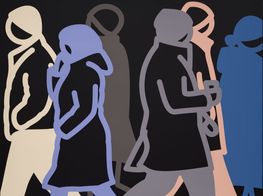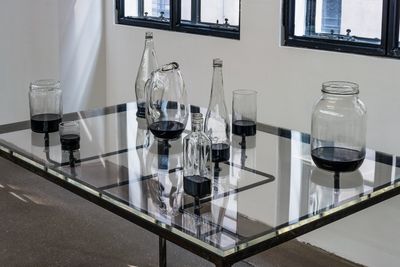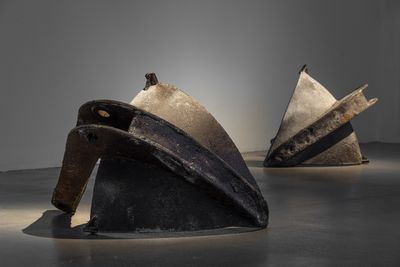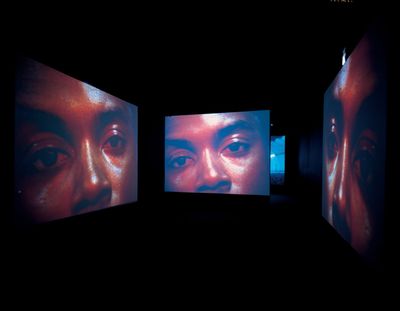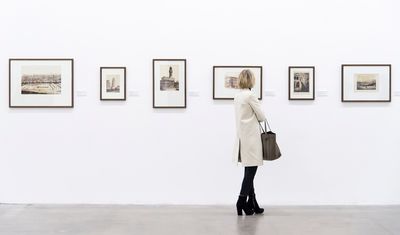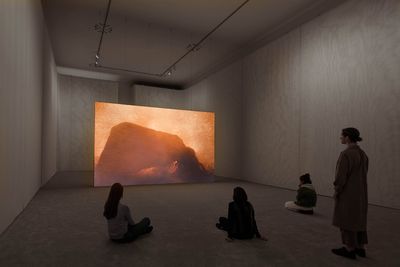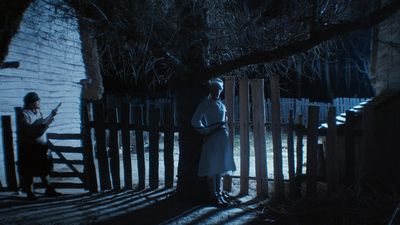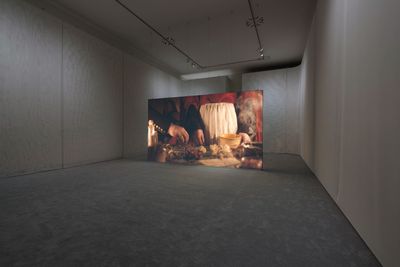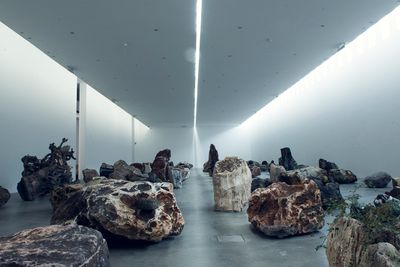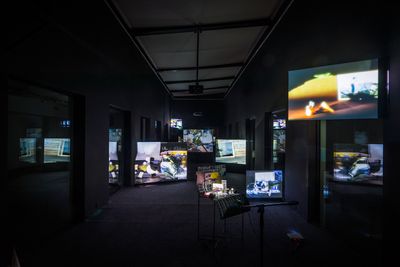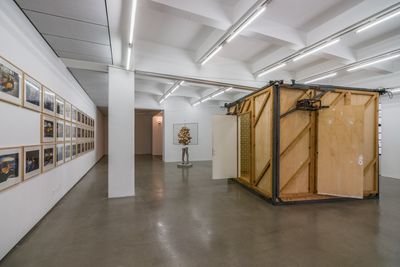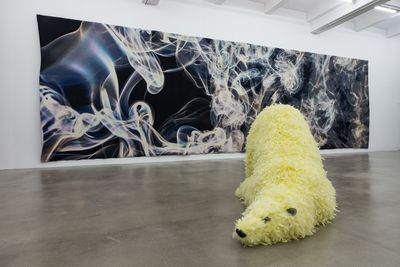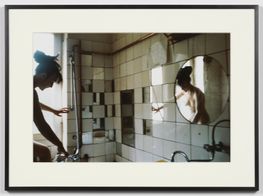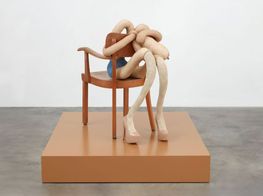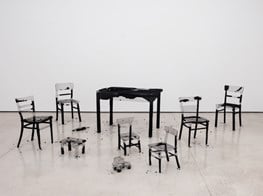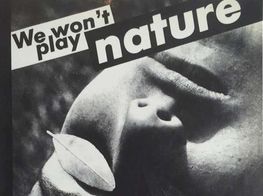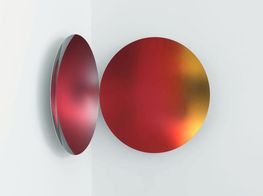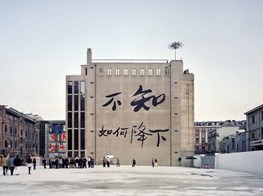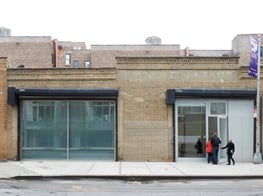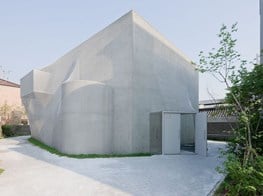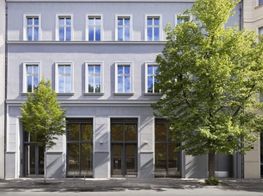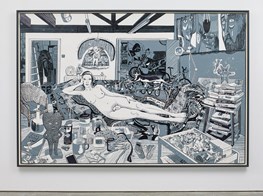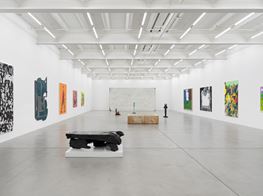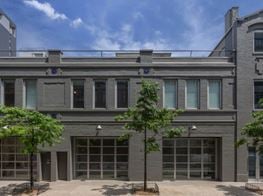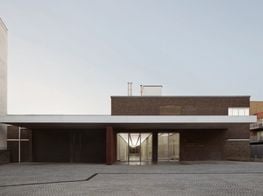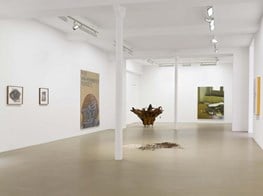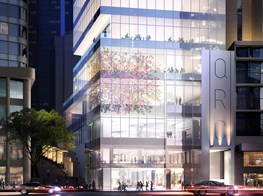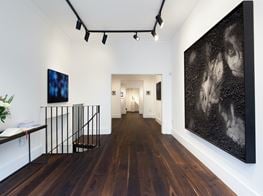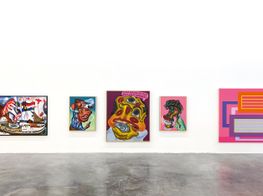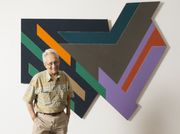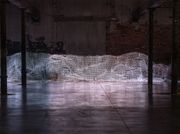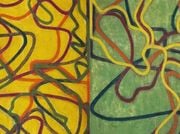Patrizia Sandretto Re Rebaudengo
Patrizia Sandretto Re Rebaudengo. Photo: Stefano Sciuto.
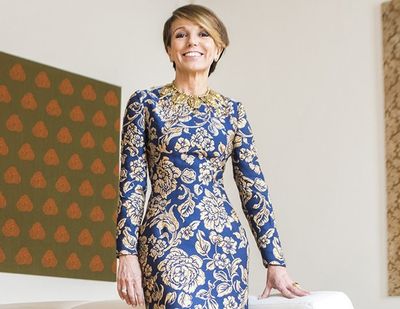
Patrizia Sandretto Re Rebaudengo. Photo: Stefano Sciuto.
Patrizia Sandretto Re Rebaudengo started collecting contemporary art in 1992, after graduating from Torino University, where she studied business and economics. She began her collection with four works from the late-1950s and early-1960s by Italian artists: Carla Accardi, Tano Festa, Mario Merz and Salvatore Scarpitta. 'I enjoyed the idea of starting a collection with works produced around the year I was born', she has noted of the choices, pointing out how far her tastes and interests as a collector have evolved since then.
Three years later, she launched the Fondazione Sandretto Re Rebaudengo, of which she is the president, and is housed in two venues: a custom-designed museum opened in 2002 as the Fondazione's dedicated space in Turin, and the converted 18th-century mansion Palazzo Re Rebaudengo in Guarene d'Alba, which opened in 1997. Today, Sandretto Re Rebaudengo's collection houses around 1,000 works from the 1980s to the present day by the likes of Maurizio Cattelan, Katja Novitskova, and Paola Pivi; and in 2020, the Fundación Sandretto Re Rebaudengo will open in Nave 9 of the Centre for Contemporary Creation Matadero Madrid. David Adjaye and Arturo Franc designed this new space to hold 100 works from Re Rebaudengo's collection from between 1990 and the present.
It is no secret that Sandretto Re Rebaudengo likes to collaborate. In 2008, the Fondazione Sandretto Re Rebaudengo launched the Foundation of Arts for a Contemporary Europe (FACE) in collaboration with DESTE Foundation, Athens; Ellipse Foundation, Cascais; La Maison Rouge, Paris; and Magasin III, Stockholm. The idea behind the initiative is to foster a global network for collaboration. 'I think it's key that private foundations and museums step up and collaborate to create opportunities and support artists, regardless of ticket sales or the market', Sandretto Re Rebaudengo has said.
Most recently, the Fondazione has collaborated with Rockbund Art Museum (RAM) in Shanghai to stage two recent shows. Walking On The Fade Out Lines (24 March–27 May 2018) was curated by the director of the Rockbund Art Museum, Larys Frogier, and the museum's senior curator Hsieh Feng-Rong. The show featured some 30 works by over 23 artists, including Marine Hugonnier and Lynette Yiadom-Boakye—from paintings and interactive installations to photography and video, among others. These were selected from the Sandretto Re Rebaudengo Collection, along with additional videos by Song Tao and newly commissioned pieces by Zhang Ruyi. The second of these collaborative exhibitions, Tell Me a Story: Locality and Narrative, was first shown in Shanghai in 2016 and will be on view in Turin from between 7 June and 7 October 2018. Curated by Amy Cheng and Ramen Hsieh, Tell Me a Story: Locality and Narrative explores contemporary art practices from across Asia through work by artists such as Au Sow-Yee, Haejun Jo and Kyeong Soo Lee, Field Recordings, and Tomoko Yoneda.
Sandretto Re Rebaudengo is described as a 'Trojan horse' by artist Doug Aitken when discussing the collector's underwriting of his 1999 Venice Biennale hit, the eight-channel video Electric Earth, and her co-producing of his 2001 film and installation New Ocean with the Serpentine Gallery. 'Beneath this calm and elegant exterior is someone who supports the extremes of art making.' Her support of the arts has not gone unrecognised. Since 1996, she has been a member of the International Council, Museum of Modern Art, New York; and member of the Friends of Contemporary Drawing, Museum of Modern Art, New York. Since 1997 she has been a member of the International Council, Tate Gallery, London, becoming a member of the Leadership Council, New Museum, New York ten years later, in 2007. She has been a member of the Committee of Contemporary Art, Philadelphia Museum of Art; the Board of Governors of the Center for Curatorial Studies, Bard College and of the Confindustria Nazionale Cultural Commission since 2008. Among other honours, she has received the Montblanc de la Culture Arts Patronage Award for her dedication to contemporary art in 2003 and was awarded the title Chevalier dans l'ordre des Arts et des Lettres by the French Ministry of Culture in 2009.
In this conversation, Sandretto Re Rebaudengo discusses some of her most recent projects, while looking back on her journey as a collector and patron.
What have been some of the most important milestones in your life as a collector? I read that the first pieces of contemporary art that you acquired were by Carla Accardi, Tano Festa, Mario Merz and Salvatore Scarpitta, but it was apparently a studio visit to Julian Opie's and Anish Kapoor's studios with Nicholas Logsdail during a trip to London that really cemented your purpose of being a collector.
It is true, the first four contemporary art works that I bought in 1992 were by the Italian artists Carla Accardi, Tano Festa, Mario Merz and Salvatore Scarpitta. They were works produced around the late fifties and early sixties. I remember looking at those paintings on the wall with interest, and they almost spoke to me; I really felt as if they belonged to me. So this was my initial approach to contemporary art. I then became an avid reader of art catalogues and books, visiting galleries and museums and, most of all, I started to get to know the artists, to visit their studios and to establish an authentic relationship with many of them—something that could certainly never have happened had I been interested in ancient art or art from the first half of the last century. Meeting these artists opened up a whole new world for me.
The trip to London in 1992 was fundamental for my collecting. I visited many galleries, including Lisson Gallery, and went to studio visits with artists like Anish Kapoor and Julian Opie. I will never forget visiting Anish Kapoor's studio together with Nicholas Logsdail. Meeting Kapoor and talking together was a true turning point. Seeing Kapoor's powdered pigment floor pieces in red, yellow and blue was a very important moment in my life, a moment of change, of developing a different way to think about art. That was the moment I decided to become a collector of contemporary art.
It's been reported that you divided your collection into the following headings when you started: British art, Los Angeles art, Italian art, work by female artists, and photography. Could you talk about how these divisions have evolved as your collection has developed?
I decided to start collecting contemporary art with a focus on works by living artists that had just been realised at the time when I bought them. To begin with, my collection was very 'generational'—it grew out of my friendships with artists who were approximately my age. I was interested in what artists from my generation thought and did, and how they saw the world in which we were living. Through them, I learnt to look ahead, to understand art being created by the youngest generations, and the themes and practices that interested them. I learned not to be afraid of what I didn't understand at first sight, and that art has the capability to communicate the strange, unfamiliar, and obscure, too.
To begin with, my collection followed five themes, each of which explored aspects of artistic production from the eighties until today: British art, artists working in Los Angeles, Italian art, female artists, and photography. As such my collection is more-or-less entirely contemporary. Photography is the only area of my collection that also has a historical dimension—I have around 3,000 historical photographs dating from the mid-1800s, which together retrace the history of the Italian landscape. But with globalisation and the widening of the international artistic scene in recent years, it is possible to reach so many artists from so many different countries and cultures that I can no longer categorise my collection by nationality, genre, or ways and means of expression. So my collection has developed more into an evolving global map of art production.
Regarding my taste, I still have the same approach I had at the beginning. In general, though, I favour art that has a political and social dimension, so it is this type of work that continues to feature highly in my collection. Sometimes I have bought on impulse, but generally the works have been acquired with a structured collection in mind. For me, an interesting work of art captures the present, anticipates the future and, in the future, will tell a story of the past. I try not to buy works by acclaimed artists or by the usual 'key players'. I don't buy names, but works.
In light of the conversations taking place today surrounding gender hierarchies, could you talk about the focus on female artists that you have developed in your collection? You had two key mentors: Ida Gianelli, head of Turin's Castello di Rivoli, and gallerist Monika Sprüth of Sprüth Magers, right?
I have always felt particularly close to work by female artists. From the first pieces I bought when I started collecting—by artists like Rosemarie Trockel, Cindy Sherman, Annette Messager, and Barbara Kruger—to the most recent acquisitions by Alicja Kwade, Rachel Rose, Katja Novitskova and Lynette Yiadom-Boakye, I have always paid a particular attention to women. I love this part of my collection because I am interested in and feel connected to the themes that these women explore. Though I am not a feminist, I like to compare my point of view on feminine issues with those expressed by others through their art.
Ida Gianelli, the Director of Castello di Rivoli Museo d'Arte Contemporanea during the nineties, had a strong influence on my sensitivity towards women artists. During our frequent conversations, she taught me a lot about female art. In 1996, she invited some collectors—I had the chance to be one of them—to present some of their works in a group show that emphasised the vivacity of private collecting in Turin at that time. I participated in the exhibition by lending all works by women artists. I felt that those works already represented one of the major themes in my collecting. Monica Sprüth was a key figure for me as well. We have been friends for a long time. She introduced me to many women artists whose works I started collecting thanks to her.
This attention for women art is a constant interest for the Fondazione, too. In 2004, the Fondazione devoted its entire annual programme to women: exhibitions (one of them dedicated to the Turin-born artist Carol Rama, who later on was awarded the Golden Lion for Lifetime Achievement in Venice), events, publications, and talks that offered a broad and updated view of women's art and culture. Many are the women artists to whom we have devoted solo shows in recent years, like Magali Reus and Avery Singer. In November 2018, the Fondazione will present solo shows dedicated to three of the most interesting women artists on the international scene—Rachel Rose, in collaboration with the Philadelphia Museum of Art, Andra Ursuta, and Monster Chetwynd—together with a selection of works by Lynette Yiadom-Boakye from my collection. A selection of works by women artists from the collection is going to be presented in the exhibition Herstory: Women Artists from Collection Sandretto Re Rebaudengo, which will be hosted at Touchstones Rochdale gallery in the UK from July to October 2018. Among the exhibited artists are Nan Goldin, Sarah Lucas, Mona Hatoum, Sam Taylor-Wood and Shirin Neshat.
Moreover, since 2016, our Premio StellaRe Award honours women who, through their work, commitment and ideas, have broken new ground in a wide variety of fields of knowledge, with special regard to the most complex cultural, political and economic strategies that organise today's society. The prize for Premio StellaRe is a ring that is designed and made by artist Maurizio Cattelan: a very classical engagement ring, only in an enlarged size, measuring five centimetres in diameter, and is a single piece. Among the winners of the Premio StellaRe are architect Kazuyo Sejima and Lisa Phillips, Director of New York's New Museum.
You have always supported collaboration, proclaiming that a collection should be public, and this mandate forms a core part of the Fondazione's work. As an example, Rachel Rose was the inaugural recipient of the Future Fields Commission in Time-Based Media, which is jointly awarded by the Philadelphia Museum of Art and the Fondazione Sandretto Re Rebaudengo. Rose is currently exhibiting Wil-o-Wisp (2018) at the Philadelphia Museum of Art until 16 September 2018 before it comes to Turin. What have these collaborations taught you?
Working together makes it possible to produce very ambitious projects, and to help artists realise their projects, as is the case with the Future Fields Commission. With the Philadelphia Museum of Art, there has been a long history of collaborations: we share ideas on the artists we like and want to support together, and I have also been a member of the committee for contemporary art at the museum for the last ten years. Collaborations can also involve confronting different ideas, entering a dialogue that can take you somewhere else. This is really exciting—maybe more difficult at the beginning of the process, but definitely very enriching at the end.
How will your vision for the Fondazione expand with the new Madrid space?
Over 20 years of experience in promoting contemporary art has led me to take this step. I was motivated by the desire to broaden the scope of the institution I founded in 1995, taking it to the context of a major European capital. I like to think that the institution that bears my name and that of my family now has three homes, which are connected by a clear, coherent philosophy, but at the same time each have defining features of their own.
Palazzo Re Rebaudengo in Guarene d'Alba is among the hills of Piedmont—an 18th-century Palazzo, opened in 1997 after being adapted as an exhibition space; we have presented many major exhibitions and special events in Guarene over the years, mainly photography exhibitions. We also ran an international arts prize there, called Premio Regione Piemonte. The Turin centre, designed by the Italian London-based architect Claudio Silvestrin, opened in 2002 in a district that spearheaded the dynamic, crucial transformation that has been under way in my city over the past decades. And now, the Madrid headquarters of the new Fundación Sandretto Re Rebaudengo Madrid will be located at the heart of a true laboratory for multi-disciplinary creation. These three settings are all attuned to the spirit of contemporary art: its ability to move between the local and global, to voice feelings of closeness and vicinity, to express relationships with the natural and urban landscape, and at the same time to invite reflection on the large-scale changes and emergencies of the present time.
Fondazione Sandretto Re Rebaudengo in Guarene and Turin, together with the Madrid Fundación, are creating a new constellation; mapping out a new geography that concretely embodies an idea of Europe based on reciprocity—between places, communities, fields of knowledge and cultures. In the past few years, the dream of opening a new foundation has taken me to visit many cities and spaces. I have chosen Madrid because I consider Spain to be my second homeland, and because Spanish is a language I know well and am very familiar with. I chose Madrid because it is a big, global capital and a bridge to Latin-American culture, a growing scene that I have been watching closely for a long time.
The Sandretto Re Rebaudengo Collection will play a major role in the new Fundación. My collection has always been open and vital: it forms the basis for the Fondazione itself, and in its 26 years of existence it has travelled all over the world. In Madrid, the Fundación will be primarily an exhibiting centre, focusing on research and on the production of new shows and new works. The collection will be broken down into work cycles and shown periodically, creating an itinerary into contemporary art of the last decades, through works of internationally acknowledged artists created between 1990 and today. The choice of works to exhibit has been made by selecting artists that have been less exhibited in Spain so far.
In keeping with our philosophy, the Madrid centre will also contain spaces for an educational department, for cultural mediation, specialised training, and artist and curator residencies. To design the interiors I chose architect David Adjaye—among his recent projects is the Smithsonian National Museum of African American History and Culture in Washington DC, strongly advocated by Barack Obama—in collaboration with Spanish architect Arturo Franco. I asked the architects to work on the idea of a welcoming place, designed for works and artists, but also for the visiting public, and the schools and families involved in our laboratories. As with the other two centres of Turin and Guarene, the principle of accessibility will be applied by removing physical and cultural barriers.
What will the opening of the Fundación in Madrid involve?
In 2002, the Turin centre of Fondazione Sandretto Re Rebaudengo opened its doors after a participatory process involving the public and private sectors: a pilot process that was unprecedented in those years. With the same approach in 2017, the project for opening Fundación Sandretto Re Rebaudengo Madrid similarly involved a close collaboration with the public sphere. In September 2015, after visiting the spaces of Matadero, I got in touch with the Municipality of Madrid, applying for the concession of Nave 9. The project was submitted to the Mayor of Madrid, Manuela Carmena Castrillo, and was officially accepted through the General Coordinator of the Municipality of Madrid, Luis Cueto, in February 2016. Since then, a negotiation has been going on with the Madrid Municipality, with the shared aim of arriving at a 50-year domain concession, in exchange for restructuring the spaces and implementing a cultural programme dedicated to exhibitions, education and research, focusing on different forms of contemporary artistic expression. The concession was formalised in September 2017, with a decree signed jointly by the Mayor and myself.
Fundación Sandretto Re Rebaudengo Madrid was instituted in January 2017. The Italian and the Spanish Foundations will have common missions, goals, methodologies and good practices. They will be connected by a trajectory that will be traced day after day through contemporary art. I hope that through my project I will also be able to contribute to the process of outward internationalisation, which is one of the policy lines that Turin is currently pursuing, and rightly so. There is still a great deal of work to do before the opening.
On the subject of outward internationalisation, Tell Me a Story: Locality and Narrative is a follow up to an exhibition staged in Shanghai as part of your foundation's collaboration with Shanghai's Rockbund Art Museum. Could you talk about how the idea for these exhibitions developed?
My interest in the Asian contemporary art scene has distant roots. In 2006, Fondazione Sandretto Re Rebaudengo presented Alllooksame, an exhibition that showed to the Italian audience a selection of works by contemporary Asian artists, curated by Francesco Bonami. The exhibition united 40 artists with Asian roots but with different backgrounds, experiences and languages.
I then became very interested in Asian contemporary art, and started collecting from that moment on. More recently, I was invited by Rockbund Art Museum to join the jury of the Hugo Boss Asia Art Award in 2015 and I'm a member of RAM's Advisory Committee, which have both been wonderful occasions to deepen my knowledge of Asian art. Moreover, last November I was invited to join the jury of the West Bund Fair in Shanghai: I had the opportunity to get to know many Chinese artists and it was extremely interesting.
In October 2016, during Frieze Art Fair in London, RAM and the Fondazione announced a new collaboration for 2018, that consists of presenting reciprocal exhibitions to share each other's cultural vision to support artists. This exhibition programme, which marks the first step of a long-term collaboration between RAM and Fondazione, allows artistic and cultural exchange between museums in the different continents of Asia and Europe.
Walking On The Fade Out Lines at RAM was the first step in this collaboration and presented a selection of works from my collection. Tell Me A Story: Locality and Narrative is the second step of this collaboration:, it will bring to Turin a selection of works by contemporary Asian artists looking at regional culture in Asia.
How do these two exhibitions sit within the history of your work as a patron of the arts, from your early days of collecting, to the launch and development of your foundation?
These shows mirror different interests and aims I pursued as collector and patron from the beginning of my professional journey. That is: collaborating with cultural institutions worldwide, making my collection visible and accessible to an ever growing public, and exploring emerging art scenes and different cultural geographies. Every chapter in this itinerary was a discovery; it helped me gain a new perspective on my collection, and find new artists, new voices, and new stories.
Peggy Guggenheim is known to be your artistic muse. What are the biggest lessons you've learned from Guggenheim's example?
Peggy Guggenheim is an absolute icon and role model for me, a woman who devoted a central role in her life to art. I read everything about her. I have visited her Venice palazzo several times—I never miss the occasion to enter those rooms and, through the exhibited works, feel her presence, cleverness, and courage.
I remember reading that the Contessa Pignatelli once told her, during a visit to her house in Venice, that Guggenheim would have had one of the most amazing houses in Venice if only she didn't have those artworks in it. When I started collecting I experienced the same: people coming to my house, admiring its architecture, but being astonished by the works and saying, behind my back: 'But how can she live with these things!' Luckily, this attitude is less frequent nowadays, as contemporary art has become more widely understood and accepted. I'm particularly glad that the current director of the Peggy Guggenheim Collection in Venice is Peggy's niece Karole P. B. Vail, whom I truly admire and who is doing a very good job.
What are some of the greatest challenges facing the arts today, from your perspective as a collector? How have you adapted in terms of the way the art world is changing?
The art market has been heavily affected by the emergence of collectors from different countries and often with huge spending possibilities. So there has been a geographical expansion but also an economic boom, which means more opportunities for artists but also higher prices, especially for the most established names. However, as a collector I have always focused on emerging talents, and what interests me the most is the accessibility of information about new areas.
What advice would you give to emerging collectors today?
First of all, allow yourself some time to understand your relationship with art and with the works of art, exploring the feelings that those works stir in you, and then start building your 'geography'. 'Space Even More Than Time' is the title of a series of works by Carol Rama, a sentence that particularly inspires me, a sort of magic formula. I think that a collection is like a trip, so you should be willing to put yourself on the go. Start travelling, visit museums and exhibitions, don't be afraid to go from prestigious art institutions to small independent projects and the other way around. The trip can start at home, thanks to the many online resources that are now at our disposal today. Then start choosing, bearing in mind the directions you wish to establish for your collection, while also leaving space for intuition and passion.
Look at the work and not at the name of the artist: this has been my guiding principle. I have always chosen works that could create dialogue within the collection and that have the capacity to speak about the present, anticipate the future and, in the future, tell a story of the past. Don't be afraid of what you don't understand at first sight and, most of all, exercise your eye: see, see, see as much art as you can.
In turn, what advice would you give to young artists trying to make a living out of their work?
The advice is to be patient and tenacious, because it can take time before an artist's work receives attention and recognition. Also, the economics behind different kinds of works might vary a lot—videos just don't sell like paintings! It is important to acknowledge that many artists, especially at the beginning, don't make a living from their artistic work, but through other activities like being assistants in studios, working in galleries and museums, teaching. These are jobs in the art world that not only help young artists to survive, but are also ways to learn a lot.—[O]

